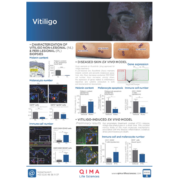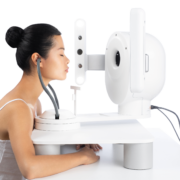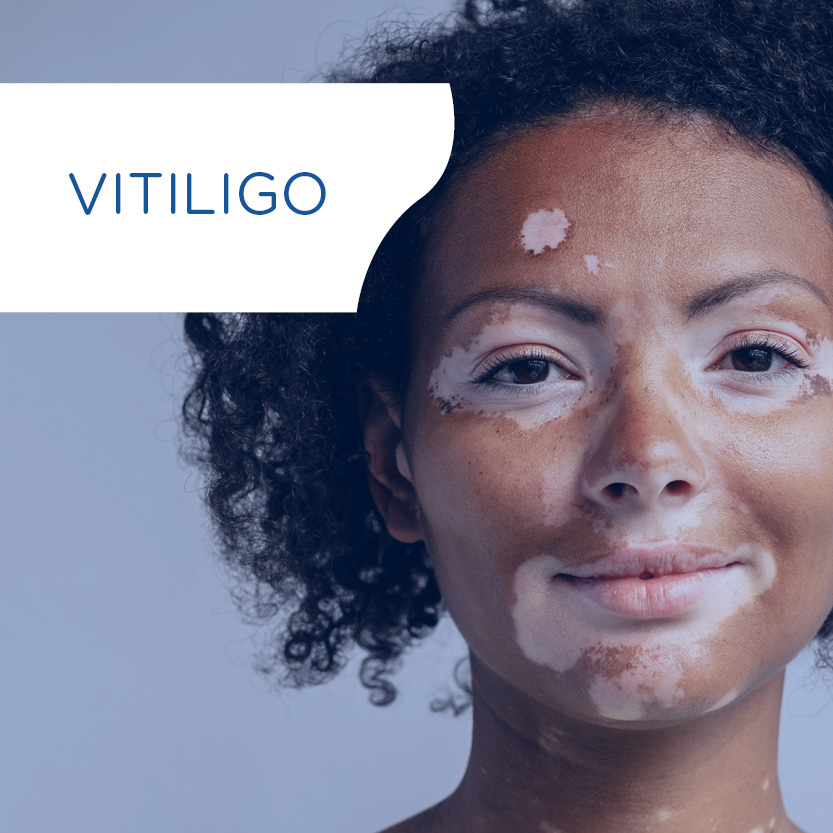Measuring vitiligo progression or facial repigmentation — a key indicator of success in most vitiligo clinical trials — has long been challenging for researchers and clinicians. The Facial Vitiligo Area Scoring Index (F-VASI) is often the primary tool used to evaluate treatment effectiveness for facial vitiligo. While valuable, this method is subjective and has notable limitations.
Our team published a study in the British Journal of Dermatology (Marin Dit Bertoud, 2023) that explored Vitil-IA®, a new automated measurement method that determines the extent of facial vitiligo using standardized ultraviolet images and a dedicated algorithm. The study aimed to assess the reliability and accuracy of using the algorithm to measure the percentage of depigmentation of vitiligo on the face.
This article provides an overview of the study and its relevance to dermatologists and the pharmaceutical industry, explaining why Vitil-IA® could transform how we measure and monitor facial vitiligo with unprecedented precision and reliability.
Share This Research Highlight
TABLE OF CONTENTS
- Clinical Assessment of Vitiligo Using Scoring
Methods- Introducing Vitil-IA®: A New Era of Precision in Vitiligo Scoring
- How Vitil-IA® Improves Clinical Vitiligo Scoring – Key Study Results
- Clinical Implications and Future Applications
- Addressing Current Limitations and Future Development
- Advancing Precision in Vitiligo Assessment: Looking Toward the Future
Clinical Assessment of Vitiligo using Scoring Methods
Current Methods for Vitiligo Scoring
Vitiligo is an autoimmune disorder that causes the loss of skin pigmentation in patches due to the destruction of melanocytes. It affects 0.5% to 2% of the global population, and involvement of the face can have a major impact on a patient’s quality of life (Gandhi, 2022; Bibeau, 2022). While there is currently no cure for vitiligo, treatments focus on restoring skin pigmentation. Because facial appearance significantly influences a patient’s psychological well-being, facial involvement is considered one of the most important factors when assessing treatment effectiveness, alongside other highly visible body areas.
The Facial Vitiligo Area Scoring Index (F-VASI) is the gold standard for evaluating the effectiveness of facial vitiligo treatments in clinical trials. Although the F-VASI is valuable, it is subjective and has notable limitations. At present, no automated digital analysis systems are available to deliver precise and consistent measurements of facial depigmentation.
The Challenges of Current Vitiligo Scoring Methods
Although the F-VASI scoring system is widely used in clinical trials, it presents several important limitations:
- Subjective interpretation, leading to significant variation between raters
- Difficulty aligning standard hand measurements with the unique dimensions of each patient’s face
- Challenges assessing small areas, such as the medial eyelids
- Problems evaluating heterogeneous pigmentation, especially during treatment
- Time-consuming manual processes, which can introduce human error
These limitations become particularly problematic when considering that many clinical trials require large numbers of patients across multiple centers, often involving raters with varying levels of vitiligo expertise.
Introducing Vitil-IA®: A New Era of Precision in Vitiligo Scoring
To address these challenges, Marin Dit Bertoud et al. aimed to develop a new automated algorithm that could provide consistent and reliable results, regardless of variations in operator technique or image acquisition. The goal was to accurately and objectively calculate the percentage of facial depigmentation.
Developed in collaboration with vitiligo experts, Vitil-IA® marks a significant breakthrough in automated vitiligo assessment. This advanced algorithm works together with the ColorFace® acquisition system to analyze standardized ultraviolet images of patients’ faces.
Automated Vitiligo Scoring – How Vitil-IA® Works
The system employs a multi-step process that minimizes human intervention while maximizing accuracy:
Image Acquisition: Patients are photographed using the ColorFace® system, which captures both frontal and side views under standardized conditions (Figure 1). Specialized UV imaging enhances the contrast between pigmented and depigmented areas, making it effective across all skin types.
Figure 1: Patients were photographed before and after the treatment with ColorFace® coupled with a UV modality (Marin Dit Bertoud, 2023).
Automated Area Division: The algorithm automatically divides the face into specific regions (Figure 2B): four zones in the frontal image (forehead, periorbital, upper perioral, and lower perioral), and three zones in each side image (malar, mandibular, and nasal). This systematic approach covers the entire face while preventing overlap between regions.
Quality Control: Built-in quality control measures require minimal human intervention. Trained operators only need to place two markers—one on an area of normal skin and one on an area of depigmented skin (Figure 2C)—along with occasional manual adjustments when necessary.
Intelligent Processing: The system detects morphological facial landmarks automatically, then applies preprocessing algorithms to highlight vitiligo lesions. Next, classification algorithms segment affected areas with high precision (Figure 2D). After segmentation, the system calculates the surface area of vitiligo (in pixels). The depigmentation percentage is then determined by dividing the vitiligo-affected surface area by the total area analyzed.
Figure 2: A Initial image, B Forehead region of interest, C Vitiligo and normal skin tone markers, D Final segmentation (modified from Marin Dit Bertoud, 2023).
How Vitil-IA® Improves Clinical Vitiligo Scoring – Key Study Results
A comprehensive validation study involving 22 patients and 13 expert raters demonstrated that Vitil-IA® delivers superior reliability compared to traditional F-VASI scoring methods.
Exceptional Reproducibility
The Vitil-IA® algorithm exhibited outstanding consistency:
- Interoperator repeatability: Less than 3% variation between different operators
- Interacquisition repeatability: Less than 2% difference between separate imaging sessions
- Automated detection: 1% of vitiligo lesion segmentations required no manual intervention
Superior Agreement with Expert Assessment
Vitil-IA® closely matched expert evaluations:
- Mean absolute error:Just 5.57 compared to expert consensus
- Near-zero bias:Mean relative error of only 0.43, indicating no systematic over- or underestimation
- Consistent performance: Accurate across various types of vitiligo presentations
Revealing F-VASI Limitations
Importantly, the study also highlighted serious limitations of the traditional F-VASI scoring system:
- Poor inter-rater reliability: The intraclass correlation coefficient (ICC) for F-VASI was only 0.45 among non-experts and 0.52 among experts—well below standards expected for clinical research
- Extreme variation in assessments: Non-expert raters’ evaluations varied by up to 84% for the same patient; even experts’ ratings varied by as much as 55%
- Particularly poor performance with heterogeneous lesions: For lesions with mixed pigmentation (common during treatment), reliability was especially low, with ICCs dropping to 0.19 for non-experts and 0.38 for experts
Clinical Implications and Future Applications
The impact of these findings goes well beyond academic research. With more than 20 ongoing interventional vitiligo studies registered on ClinicalTrials.gov and numerous new treatments in development, the need for reliable and standardized assessment methods has never been more urgent.
Enhanced Clinical Trial Accuracy
Traditional clinical trials often struggle when primary endpoints rely on subjective assessments. For example, in the Phase III ruxolitinib cream study, only 29.8% of patients in the treatment group achieved the primary endpoint compared to 7.4% in the placebo group (Rosmarin, 2022)—a difference similar to the variability observed between raters using traditional scoring methods.
Vitil-IA® can dramatically improve the reliability and accuracy of clinical trials by:
- Eliminating inter-rater variability that can hide true treatment effects
- Providing consistent measurements across multiple study sites
- Detecting subtle changes that human raters might miss
- Reducing the risk of discarding potentially effective treatments because of measurement uncertainty
Regulatory Advantages
Vitil-IA® also offers several important benefits for regulatory authorities evaluating new vitiligo therapies:
- Standardized, objective measurements that reduce subjectivity
- Reproducible results that can be independently verified and validated
- Comprehensive documentation that tracks treatment progress over time
- Increased confidence in the integrity of clinical trial outcomes
Transforming Patient Care
Beyond research, Vitil-IA® has the potential to enhance everyday clinical practice:
- Objective Progress Monitoring: Patients and physicians can track treatment progress with unmatched precision, leading to better-informed treatment decisions.
- Improved Patient Communication: Visual representations of progress can help patients better understand their condition and encourage adherence to therapy.
- Optimized Treatment Protocols: Accurate, objective data enable clinicians to fine-tune treatments based on real response patterns.
- Long-term Outcome Assessment: Consistent, reliable measurements over time provide valuable insights into long-term treatment effectiveness and disease progression.
Addressing Current Limitations and Future Development
While the initial validation study shows great promise, the researchers recognize a few important limitations, highlighting opportunities for future improvement:
Skin Type Diversity: The current study did not include patients with skin types V or VI. Although vitiligo lesions tend to be more easily distinguished in darker skin, it remains essential to validate the system across all skin types.
Expanded Validation: As this is the first clinical application of the ColorFace® system and the Vitil-IA® algorithm for vitiligo assessment, larger, multi-center studies will be necessary to confirm these promising early results.
Integration Considerations: The system requires standardized imaging conditions and specialized equipment. These needs may initially limit its widespread adoption compared to traditional assessment methods.
Advancing Precision in Vitiligo Assessment: Looking Toward the Future
The development of Vitil-IA® represents more than a technological advancement—it marks a shift toward precision medicine in dermatology. As new treatments, such as JAK inhibitors and other innovative therapies, continue to emerge, the demand for reliable, objective assessment methods becomes increasingly critical.
Vitil-IA®’s ability to detect even subtle changes in pigmentation makes it ideal for monitoring treatment response as well as disease progression and relapse. This comprehensive approach has the potential to transform how vitiligo is understood and managed.
Additionally, the underlying principles of Vitil-IA® may extend beyond facial vitiligo. The approach could be adapted for use on other body areas or even other pigmentary disorders. By combining standardized imaging, automated analysis, and minimal human intervention, this scalable solution could revolutionize dermatological assessment as a whole.
Discover our articles
Download Our flyer
Watch Our Short Video

Learn more about our
Imaging Systems
The ColorFace®
Watch Our Webinar Replay
Interested in the Vitil-IA® technology?
Contact our experts to discuss the capabilities and applications for your project.
Written & Edited by:
Sabrina Hoefling, PhD
Innovation Marketing Project Leader










